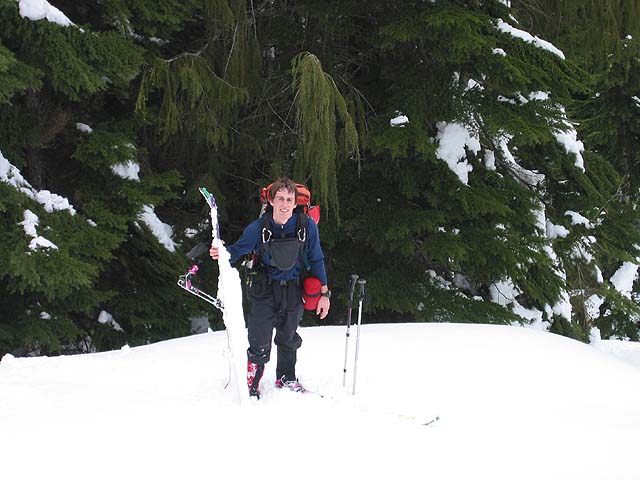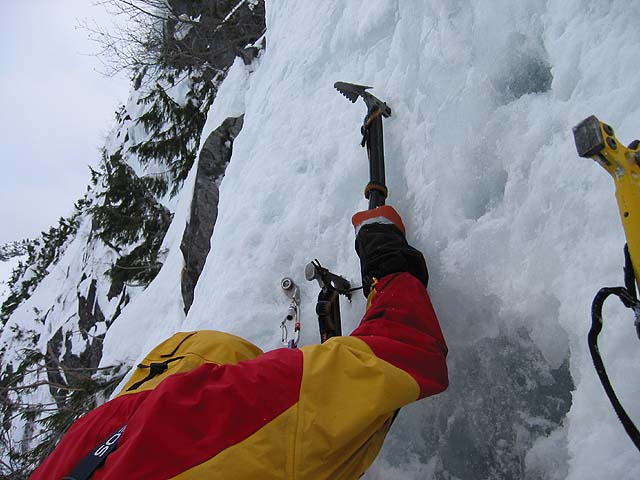Ice Climbing - Part 1
This is the story of big, fat, scary Washington ice. The area is unlike any other I've seen in Western Washington, and probably harbors the largest and hardest reliable ice on the west side. The massive quantities of ice also leads to many climbs in the more moderate ranges as well. But lets back up and tell how the area was discovered...
Phil Fortier originally scoped this area out for a skiing destination. It looked reasonably close to a road and had lots of good steep terrain. He was able to ski up in there one day later in the low-snow winter of 2000-2001. On this trip he discovered the ice climbs. Huge flows, some over 100 feet wide, and all at least 2 pitches in length! The pictures he brought back were stunning, and we soon banded together to head back in there with ice gear.
We headed up there for a day trip in early March of 2001 under dubious avalanche conditions. Upon reaching the area we found the climbs to be fat, but nearly continuous wet sluffs were coming down them. We skied over to the base of the far left hand climb, but things were far too unstable to climb. The slopes above that feed these climbs so well are also their biggest threat. We soon bailed and skied home, determined to come back next year.
A summer passed and the area went to the back of our minds. Soon however, the restless winter of 2001-02 began. Ice climbers everywhere were in despair at the poor ice conditions all over Washington State. Sure enough, I spent most weekends skiing and only a single ice climbing. In fact, Phil had seen no ice at all since Alaska. But we held out hope for the stash of huge fat climbs because they were so North facing, and so huge last year.
The cold snap of early February hit. Snow in Seattle, but big danger in the mountains. We waited longer. Then it came, a full week of clear weather in mid February (exactly the same as this week last year). Phil and I decided to head back to the area and check it out. Unfortunately, the good weather was ending Sunday, and so we had only a day trip to work with.
The road that was ploughed so far last year was stopped short still this season. Phil had skied up the road a few weeks before and it had taken him only an hour and a half to the "turn-off" to the area. Nonetheless, we decided to utilize Phil's snowmobile to drive up the road more quickly. This turned out to be crucial in giving us enough time to complete our day trip.

Phil on the slightly branchy approach.
We crossed the creek easily on rocks, and were soon skinning up towards the area. We made quick work of the lowlandish approach, and were soon on the headwall of the valley. We opted to try a new approach up through the trees of the headwall this time. This way we could bypass the tediously long and sometimes dangerous avalanche slope on the left hand side of the valley. The snow was incredibly sticky and my skinns were balling up horribly!

Dave's stupendously balled up skis. Photo: Phil
Fortier
Even with the tough snow conditions, it took only two hours to make it up to the climbs from the road turnoff, about 1,700 feet and 1.5 miles. The climbs looked scary. Even in this "bad ice year", the climbs were thick and huge. However, they were far more plastered with snow, and the last pitches of most of the climbs looked seriously buried.

Phil approaches three of the main climbs.
We skied over to the base of the major climb of the area. We initially thought it would go at 3 pitches and only a 40ft. section of grade 4 pillar in the middle. When we arrived at the base, things looked much more grim. The "approach" WI2/3 pitch looked more like sustained grade 3-4, and the pillar was almost certainly longer with grade 5 difficulties. At the last moment we decided to climb the flow on the right. It looked to be one long pitch with some rampy and then steep climbing. As usual with in this area, the climb deceived us with its looks.

Phil leads off on the first pitch.
Phil lead off first, and easily climbed up a half pitch of WI3 to a belay under a roof. I followed, noticing that this ice seemed a lot harder than it looked like from below. As I reached the belay, I tried to traverse under Phil and climb up and to the left. I began hitting rock with my tools. Shouldn't this be ice under the snow??? We re-racked, and I lead off on a cool narrow left leaning ramp of ice. The conditions were changing every five feet. One second you're on good ice, the next your tools are wallowing in sugar snow, searching for that next stick. I continued up and left, until reaching a steep short traverse. The ice became very bad, or nonexistent. I crossed the 75-80 degree ground very tenuously with only shafts behind the tentacles of ice buried deep in the snow. I was now very run out, and looking at bad fall potential. The only way was up, and it was bonafied 'mommy territory.' A short 90 degree wall of slush stood right in my face. Completely off balance, I tried very hard not to pull on my one tool as I set a screw off to the side. The screw only went in half way, and I clipped off the hanger. It would have to do, I couldn't stand here any longer.
I made it up the step, and the ice conditions improved. All of a sudden, I heard the unmistakable rumblings of an avalanche. I looked up and saw a huge cascade coming down at me. I set both tools and waited. Fortunately, the powdery waterfall (maybe 10 feet in diameter) flew just off down the rib 15 feet to my left, and left me with only a slight dusting. Even on this day of "Moderate danger below 7000 feet", the slopes above the climbs were releasing sluffs. I think the balls of snow dropping from the trees were the culprits because of the monster snow chunks that always preceded the sluffs. The rest of the climb continued on steep steps with fat plastic ice. I set in a solid belay and brought Phil up.

Phil climbs up the second pitch. Those dots in the background are our
skis!

Phil grovels through slush and snow to the top. An action all too familiar on this pitch.
Sluffs continued to come down about every 5 minutes as we setup our rappel. There was about another 50 feet of grade 3ish ice above, but we finished the climb there because it was far too dangerous to risk a v-thread from the snow-spigot at the very top. I rapped down first, and was overjoyed that after untangling the ropes, I could see they just reached the base of the climb (off to the side of our start). This was lucky too, because the ice on this bottom section was only 1" thick. Glad we didn't have to try v-threading off of that!

Dave at the belay. Photo: Phil Fortier

Hey, that's why my crampons felt so lame!
The sky grew dark and the forecasted rain had just begun to fall. We had spent an amazing amount of time on this one climb. Two pitches in three and a half hours. If nothing else, it can give you perspective on how difficult the ice conditions commonly are in this area. We could only look over and wonder how difficult the "main" flow was with it's stretch of near vertical, finicky ice.

Our climb, Sno Fun. Kinda like "Snow", kinda like "No"!
We were out of time for the day, but satisfied with our ascent. We decided to call our climb Sno Fun (WI4, 2p). The ski down with the heavy ice packs was a mix of fun glades and icy survival skiing. Once we were back at the 'bile, it was and easy ride back to Phil's truck.